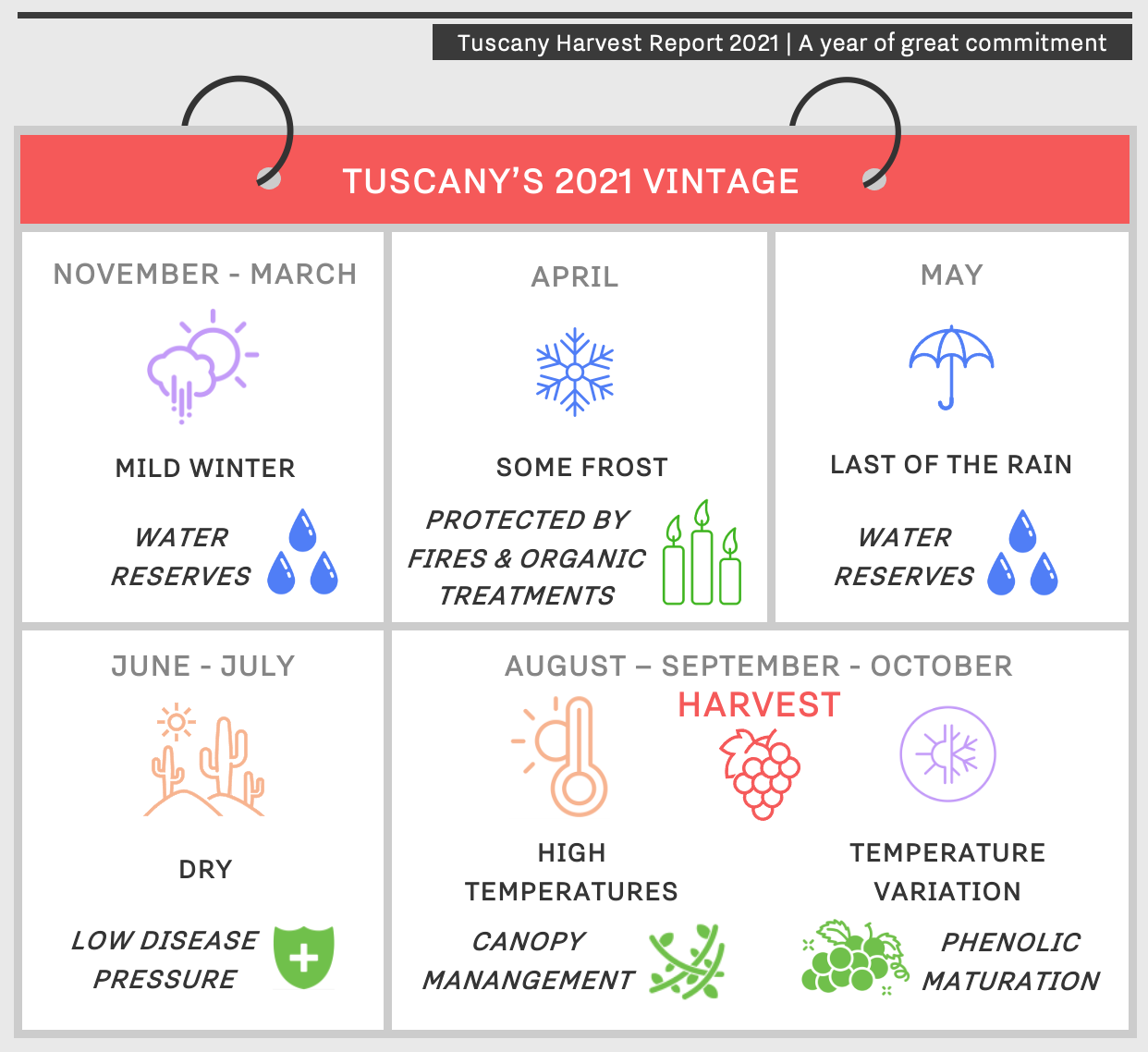The balancing act
Following our recent report on Bordeaux’s 2021 harvest, Wine Lister now turns to Tuscany to find out more about its 2021 vintage so far, with insight from 10 top producers across the region
Tuscany’s 2021 growing season has been characterised as a year of climatic extremities, including a mild and rainy winter, the onset of frost in spring, persistent drought in summer, and ending in ideal harvest conditions. In a show of resilience and adaptability, producers were able to reap the benefits of acute weather patterns - with the potential consequences of drought lessened by the groundwater reserves accumulated in winter, and dry conditions reducing disease pressure over the summer.
What can we expect from Tuscany’s 2021 vintage?
Multiple methods to fight frost
- Properties lit fires in the vineyards to circulate warm air and reduce the risk of frost. Owner of IPSUS, Giovanni Mazzei tells us that the technique successfully “increased the temperature up to 2˚C” across the IPSUS vineyards, protecting the vines from damage
- Several producers used organic treatments to improve vine health following the frost, including Argiano, whose Sales Manager, Riccardo Bogi tells us that “brown algae allowed the plants to stabilise and respond as quickly as possible to the loss of sprouts”
- Frost was particularly prevalent in low-lying coastal regions, with Ornellaia’s winemaker, Axel Heinz witnessing “damages limited to a few lower altitude vineyards, without significant impact on production”. Le Macchiole’s Commercial Director, Gianluca Putzolu tells us that the estate also implemented “organic spring fertilization” to combat frost that hit “some, but fortunately very few vineyards”
Water reserves
- Rainfall during winter accumulated important water reserves at both Argiano and Romitorio, encouraging a good state of hydration ahead of the growing season
- Some high-altitude properties also saw snowfall during winter that, when melted, “percolated the soil with water”, according to Romitorio’s owner, Filippo Chia
- Abundant rainfall in May allowed plants to survive the hot summer, with Riccardo confirming that this was “essential” for Argiano’s 2021 vintage, “since after that, there was no rain until the beginning of October”. Similarly, Fèlsina’s owner, Giovanni Poggiali tells us of some “rainy days in June”
Sun and heat exposure
- “The management of the canopy needed to be delicate and precise to avoid sunburns”, explains Avignonesi’s COO and Agronomist, Alessio Gorini, who also explained that the use of high-tech sorting equipment allowed them “to completely remove any berries withered or raisined by the sun”
- Organic treatments were adopted to protect the vines from sun exposure, such as the use of “kaolin” at Tenuta San Guido. General Director, Carlo Paoli explains this to be “a natural substance that we have been using for many years in hot vintages”, which helps to reduce the vines’ susceptibility to scorching
- A broad diurnal range across several high-altitude estates encouraged balance despite the hot summer, with Castiglion del Bosco’s winemaker, Cecilia Leoneschi noting that the difference of more than 10°C between day and night temperatures was a “real blessing”
 Teamwork amongst Tuscan vines: IPSUS (left), Tenuta San Guido (middle), Ornellaia (right)
Teamwork amongst Tuscan vines: IPSUS (left), Tenuta San Guido (middle), Ornellaia (right)
A remarkably healthy vintage
- Lack of rain throughout June and July minimised disease pressure; Filippo confirmed that “from a mould and disease standpoint, it was actually one of the healthiest vintages [Romitorio] has seen”, thanks to the “dry summer”. Giovanni echoes this sentiment for IPSUS, while Gianluca reiterates there were “no particular problems” at Le Macchiole, despite the risk of powdery mildew – a more common problem for the Bolgheri area
Striking when the time was right
- For many estates, harvest timing was essential, with Alessio and the Avignonesi team similarly conscious of “avoiding over-ripening on such concentrated grapes”
- Producers had to be particularly reactive to picking dates, explains Axel – whose 2021 harvest “required great skill” in planning, eventually leading to a “very compact harvest completed in one month, instead of the usual 40 days”. Owner of Tua Rita, Giovanni Frascolla similarly characterised 2021 as a “lightning harvest”
Balanced acidity
- “Powerful dark structure - we normally see this with low acid, but this has high acid” recounts Filippo from Romitorio’s latest tasting of the blend
- First impressions show “bright aromatics and, luckily high acidities to keep everything in balance”, at Ornellaia, with Axel describing a “rich and concentrated” wine, “with soft tannins”
- “Grapes matured in a homogeneous way and with a perfect balance of acidity and PH” explains Carlo at Tenuta San Guido
